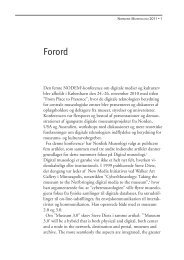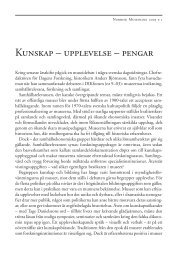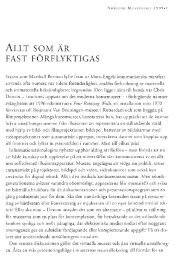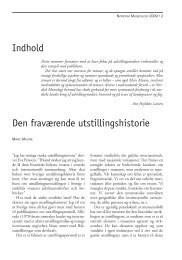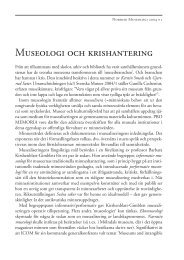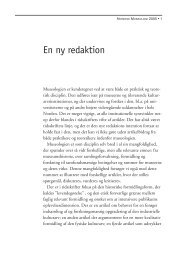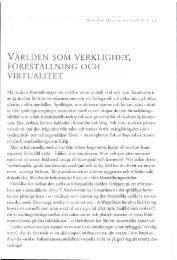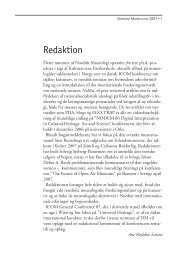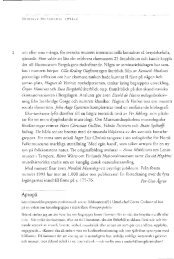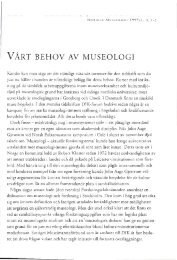ANMÄLAN - Nordisk Museologi
ANMÄLAN - Nordisk Museologi
ANMÄLAN - Nordisk Museologi
You also want an ePaper? Increase the reach of your titles
YUMPU automatically turns print PDFs into web optimized ePapers that Google loves.
BJØRNAR OLSEN<br />
58 i dag, ihvertfall ikke når det gjelder arkeologisk<br />
formidling. Vi trenger muldvarper<br />
som kan underminere noe av tatt-for-gitthetene,<br />
og selvforherligelsen i dagens<br />
museumsverden. Det er selvsagt ikke noe<br />
galt i å formidle den kunnskap man idag<br />
har om fortiden. Det både skal og bør man<br />
gjøre. Men man skal også formidle hvordan<br />
denne kunnskap fremkommer, hvilke konflikter<br />
den er involvert i, og hvordan den<br />
endres. Marinetti ønsket å rive museene.<br />
Det er kanskje å gå for langt. Men de må<br />
helt klart ristes litt i.<br />
SUMMARY<br />
The Arcbaeoiogifal Museums - Some Critical Points<br />
Archaeology's public identity is inextricably linked to<br />
museums and museum practice. The museum exhibitions<br />
constitute the main point of contact between<br />
archaeology and the public. In official scholarly and<br />
political discourse the social role of the museum is<br />
claimed to be that of the protection and conservation<br />
of prehistoric material and the presentation of knowledge<br />
about the past to the public. Furthermore, it is<br />
often maintained that the museum should provide a<br />
connection with history and a stability and thus<br />
impart to society a sense of its roots and its identity.<br />
This paper argues against this sympathetic view of the<br />
museum's social role. Instead it is claimed that, to a considerable<br />
degree, the historical and archaeological<br />
museums serve to legitimise ideologically our modern,<br />
western way of life. The main argument is that most<br />
archaeological exhibitions eliminate what is particular<br />
and conditioned by the precise situation in time to both<br />
the past and the present. Focusing on well-known and<br />
easily recognisable categories such as technology, economy,<br />
settlement and religion, the historicity and difference<br />
of both the past and the present are erased. Both the<br />
bizarre in and the alternatives to our own way of life are<br />
concealed in this modern museum meta-narrative.<br />
One of the reasons why archaeological exhibitions<br />
have become servants of current ideological interests,<br />
is that those who produce the exhibitions mainly<br />
regard their task as a question of communication. This<br />
emphasis on rhetoric, e g how to present the message<br />
in the most pedagogical and convincing way, has displaced<br />
any discussion of the crucial problem concerning<br />
the production of archaeological knowledge.<br />
Instead this rhetoric assumes an idyllic consensus<br />
about the past, that there exists a given portion of<br />
knowledge, and that the main problem consists in<br />
transferring this knowledge from the archaeologist ro<br />
the public.<br />
To alter this situation, a new muscology has ro<br />
focus on the problems involved in the production of<br />
knowledge. It has to visualise this production as an<br />
active process in a current socio-political context.<br />
There is no genuine and homogeneous past to be<br />
brought into harmony with archaeological thought<br />
and then neutrally re-presented to the public.<br />
Exhibitions should focus more on the plurality of<br />
interpretations and stimulate the interpretative creativity<br />
of the visitors. This also involves showing them<br />
how the interpretations of the past have changed<br />
through time and what they changed in response to.<br />
Finally, and maybe most important, a new presentation<br />
of the past has to emphasise the difference and<br />
otherness of the past. Doing this will enable us to place<br />
our own values, morality and reasoning, the universality<br />
of which we take for granted, in a cultural and<br />
historical context.<br />
Bjørnar Olsen, mag.art. i arkeologi, ansatt som arkeolog<br />
ved Tromsø universitet. Arbeider med orientering mot et<br />
bredt spekter av spørsmål knyttet til arkeologiens teoretiske<br />
fundament. Var gjestende forskningsstipendiat i<br />
Cambridge 1985-86 (Adr: Tromse Museum, Ark. avd..<br />
Folkeparken, N-9000 Tromse).



